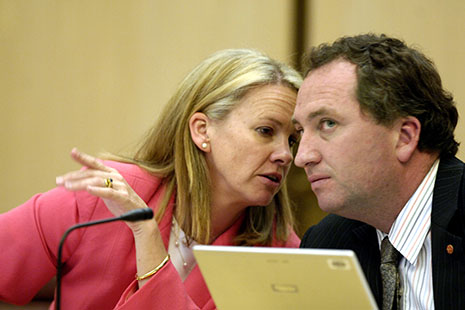AS THE OPPOSITION continues to avoid any semblance of genuine curiosity as to why it lost government in 2007 – apart from some caustic (and telling) asides on The Howard Years – it has descended to the Coalition’s normal out-of-power mode of name calling and infighting (mostly for all the wrong reasons).
Languishing in the polls and with Turnbull trailing Rudd by light years in the preferred prime minister stakes, the Liberal Party, instead of asking how it became so detached from voterland, has turned on the Nationals. (Fair enough, a cynic might say, as they can’t lay a glove on Labor.)
What this does is call into question the whole dotty idea of a coalition in opposition. What purpose does it serve? In fact, if the Nationals reflect for even a nanosecond they will see they are on a hiding to nothing – and this at a time when they are fighting for their very survival, having reached the nadir of their parliamentary representation after the 2007 defeat and the by-election loss in Lyne earlier this year.
The best way for the Nationals to secure any sort of viable future is to carve out an identity quite separate from that of the Liberals, and build once again a constituency of their own. While they had a share of power for the eleven and a bit years of Howard, it came at a cost. For a start, the neoliberal dog that began its economic rationalist howl in the 1980s met with only token resistance from the National tail. It was the bush that suffered as services were withdrawn and the traditional economy was left with little protection. That spawned One Nation.
It is little discussed, but the Howard policy initiative that cost the Nationals so dearly in terms of its once huge membership was the gun buyback in 1996, post-Port Arthur. Beginning in Queensland, where its impact was felt hardest, the exodus of members rapidly spread around the country. They have never returned.
It remains to be seen how the merger in Queensland plays out. Tensions still run high, and there is good reason to suppose that a viable rump party will emerge – the very spectre that has always in the past carried the argument against merger. Already, the new organisation is seeking to levy its parliamentary members to help reduce the massive debt inherited from the dysfunctional and spectacularly unsuccessful division of the Liberal Party in Queensland.
Mutterings are starting to surface among Liberals that it is time to stop indulging the Nationals (and especially Barnaby Joyce) and declare all-out war. But this been tried before, and it failed. In Victoria from 1935 to 1943 and again for two subsequent shorter periods, the Country Party (as it then was) governed as a minority administration with Labor support. This had to do with a rural bias in the electoral system as much as anything else. But the Liberals (and the United Australia Party before them) huffed and puffed in impotent opposition.
After the second world war, the Liberal Party called for a merger but twice the Country Party refused. (At the national level, the Country Party had already declined an invitation by Robert Menzies to attend the conference of non-Labor organisations that led to the formation of the Liberal Party.)
The Liberal Party then started its own war and one with a single aim: to eliminate altogether the Country Party. It provocatively changed its name to the Liberal and Country Party and lured six Country Party members of the Victorian parliament into the Liberal fold. The Country Party never again reached its old prominence – especially after Labor in 1952 formed the first majority government in decades and redrew the electoral map. And while it was never a part of the Liberal ascendancy from 1955 to 1982, it never vanished despite a concerted Liberal assault at election time. Indeed, it came in from the cold to join forces with Jeff Kennett’s Liberals in 1992.
The party in Victoria has continued to maintain an identity separate from the Liberals, and its ongoing existence in that state is secure, Julian McGauran’s defection notwithstanding.
The federal Liberals like to boast how they hold more non-urban seats than the Nationals, as if this were some sort of justification for an offensive. But would Australia outside the cities really be better represented by a minority within the Liberal Party than it would by a stand-alone non-urban party? This is the same argument that led to the formation of the Country Party some ninety years ago, and while the structure of the economy and the demographics have changed, the politics remain the same.
One of the most engaging politicians in Australia right now in the Nationals’ Senate leader, Barnaby Joyce. The rest of his opposition colleagues might take the time to see a constructive oppositionist at work, and a politician who actually takes seriously the ideas of representing a defined constituency. And the founding fathers of Federation, so long in their graves, can take some posthumous satisfaction in the fact that a member of the upper house has at last filled the role that they envisaged.
The Nationals would be far better off – both as a party and as representatives of their constituency – if they went it alone. A coalition in opposition really makes little sense – and a lack of unity, as is being trumpeted by the Liberals right now, could be a blessing in disguise for Joyce and his colleagues. After all, as we saw in Western Australia this year, the Liberals will always come, cheque book in hand, if there is a sniff of government in the air. Better to have a price than to be regarded as carry-on baggage. •




